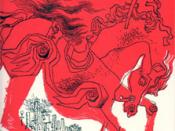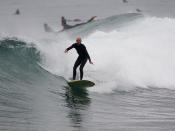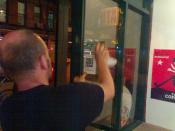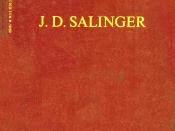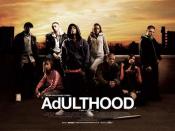Through the exploration of the links between J. D. Salinger's novel "The Catcher in the Rye" and "Rebel Without a Cause" directed by Nicholas Ray my overall understanding of the two texts has been illuminated, as have I been made aware or the alien and new in regards to new found lands. The two texts have many contextual similarities, although their form differs. It is because of the similarities along with filming and literary techniques that my understanding has grown as has my knowledge on new found lands.
The similar/common themes include conformity and rebellion, the coming of age; a need to be in control and maintain/protect their self proclaimed ideal world and the 1950s concept of perfection and idealism which leads to the epidemic of 1950s teen depression, all of which are new found lands. When the book and the film are analyzed a greater understanding of this era and new found lands becomes clear for we are given visual aid from a 3rd personÃÂs view, as well as a book creating a vivid verbal description in 1st person.
In the book ÃÂCatcher in RyeÃÂ, the main character Holden is against conformity. He has a hatred of the world that surrounds him; he finds it to be superficial, wasteful, corrupt and idealistic which is shown in through SalingerÃÂs use of cynical languageÃÂ ÃÂLike hell it is.ÃÂ I took it off and looked at it...ÃÂI shoot people in this hat.ÃÂWhere we see that he desires independence because he feels that the world is an inhospitable, ugly place that, he feels, deserves only contempt. These are the thoughts that fuel his fears of joining adulthood as he sees adults as the biggest ÃÂphoniesÃÂ of them all. Holden throughout the book wears a ÃÂred hunting hat on backwardsÃÂ. This motif is present throughout the novel, and symbolizes a refuge from the conformity of society.
In the film ÃÂRebel without a causeÃÂ it is Jim who fears to blend in with his idea of a superficial society much like Holden. In the film it is evident that the underlying reason for JimÃÂs rebellious acts and fear of society come from his insecurities. Jim wants to be accepted by his peer group and be popular by standing out. It is this that led him into problems relating to his peers. He hates the idea of being called ÃÂchickenÃÂ. This is particularly noticeable in the scene outside the planetarium when he is confronted by BuzzÃÂs gang. The medium shot when Buzz produces his flick knife sees Jim counter with his crow bar. The camera moves back and forth quite quickly creating suspense. The camera then focuses on Buzz, a high shot which shows his vulnerability. Jim is forced to prove his manhood by agreeing to the ÃÂchicky runÃÂ. ÃÂSuppose you knew that you had to do something very dangerous, where you have to prove something you need to know, and a question of honor. Would you do it?ÃÂ When Jim questions his father it is clear to see his insecurities about societyÃÂs perception of him. It is his need to stand out from the conformist world that leads him to find shelter in wearing a red jacket, for the people around him are all in black leather.
Both boys feel the pressures of conforming to an image of perfection. It is through analyzing both texts that it becomes evident that the pressures come from the era. With the aid of the two texts both the visual and literal we are able to learn about the new found land of the 1950s and then compare it to the society we are surrounded by. The director has used the third person view of the film to bring this to surface. The film provides us with an insight into the further reasoning behind HoldenÃÂs hatred, which was not previously obvious. As with just the book we were only given his biased explanation and personal opinion but the movie helps us see the new found lands of the 1950s from an un-biased view and so we are able to see more pressures facing Holden. This in retrospect enhances our understanding.
Throughout the book Holden is facing a change into adulthood and a growth in maturity. To Holden this change means the end of the real world, a growth in phoniness and a loss of innocence. It can even be said that he is scared of adulthood. ÃÂI have to catch everybody if they start to go over the cliffÃÂ Id just is the catcher in the rye and allÃÂ. Through symbolism we see his wish to stop adulthood and preserve the innocence of being a child not only for him self but for the entire society of which he is a part. He has a desire to be in control of his life, and to him the only way of doing so is to maintain the world that is satisfying to him.
Jim also has a fear of growing up and turning into an adult. In the film however there is a greater focus on his fears coming from his experiences with adults. For example, Jim is ashamed of what his parents have become; his father is supposed to be a man but instead is weak and controlled by his intimidating dominant mother. Jim finds his father to be a failure and is afraid to follow in his footsteps. This is evident in the scene he finds his father wearing a ÃÂMary Petty apronÃÂ serving Jims mother. We are shown his weakness through a high shot of him, while he is on his hands and knees. Through the dialogue in this scene we are made aware of JimÃÂs disappointment.
ÃÂMom?ÃÂÃÂHiya JimboÃÂ ÃÂYou thought I was mom?ÃÂÃÂYeah!ÃÂJim does not want to grow up, as this would give him the opportunity to become a failure in the eyes of someone else and not have the excuse of being a child to fall onto. He wishes to keep the world he has grown up living in, the world he has harnessed.
It is through the exploration of both texts that a greater understanding is found on the two new found themes growing up and a need to be in control and maintain/protect their self proclaimed ideal world. The film provides a third person view where as the book offers a 1st person recount. Our understanding is also illuminated because the book and film focus on different reasons for a troubled change into adulthood. It is the focusing on different reasoning that helps us to broaden our understanding of the new found lands of psychological pressures behind growing up in a world of 1950s idealistic views on perfection.
The filmÃÂs third person view compliments that of the 1st person recount offered by the book, through the exploration of the common themes faced by the two teenage boys growing up in the 1950ÃÂs. The literal and visual texts show different angles on similar situations, illuminating each other, providing a greater understanding for both texts and the new found lands that are present in both. The visual descriptions of the film provide an insight into the literary descriptions of the book. Where as the vivid verbal descriptions reinforce the images of the film. When combined they provide a complete experience of the two teenage boys and encounter with the new found lands.
